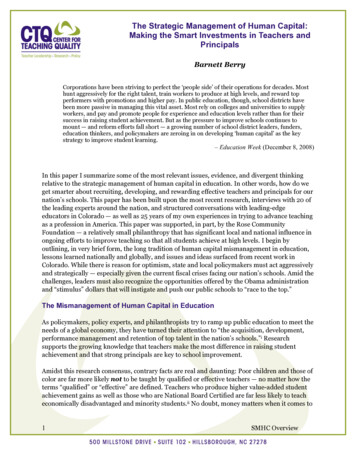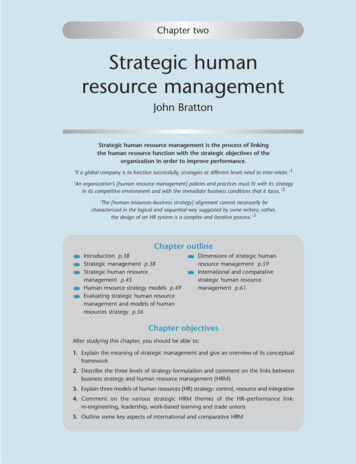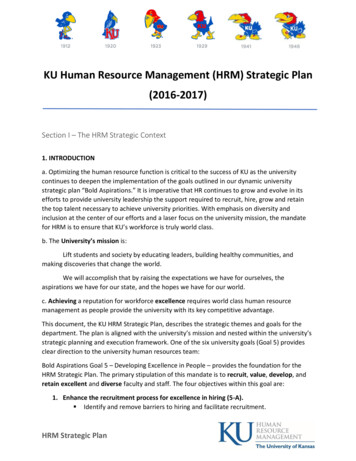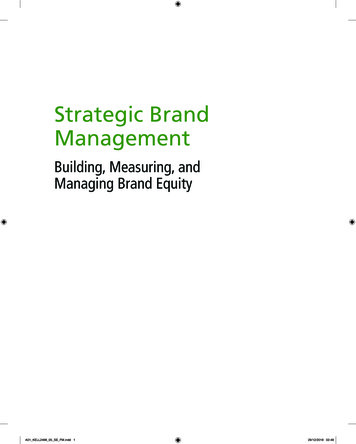
Transcription
The Strategic Management of Human Capital:Making the Smart Investments in Teachers andPrincipalsBarnett BerryCorporations have been striving to perfect the ‘people side’ of their operations for decades. Mosthunt aggressively for the right talent, train workers to produce at high levels, and reward topperformers with promotions and higher pay. In public education, though, school districts havebeen more passive in managing this vital asset. Most rely on colleges and universities to supplyworkers, and pay and promote people for experience and education levels rather than for theirsuccess in raising student achievement. But as the pressure to improve schools continues tomount — and reform efforts fall short — a growing number of school district leaders, funders,education thinkers, and policymakers are zeroing in on developing ‘human capital’ as the keystrategy to improve student learning.– Education Week (December 8, 2008)In this paper I summarize some of the most relevant issues, evidence, and divergent thinkingrelative to the strategic management of human capital in education. In other words, how do weget smarter about recruiting, developing, and rewarding effective teachers and principals for ournation’s schools. This paper has been built upon the most recent research, interviews with 20 ofthe leading experts around the nation, and structured conversations with leading-edgeeducators in Colorado — as well as 25 years of my own experiences in trying to advance teachingas a profession in America. This paper was supported, in part, by the Rose CommunityFoundation — a relatively small philanthropy that has significant local and national influence inongoing efforts to improve teaching so that all students achieve at high levels. I begin byoutlining, in very brief form, the long tradition of human capital mismanagement in education,lessons learned nationally and globally, and issues and ideas surfaced from recent work inColorado. While there is reason for optimism, state and local policymakers must act aggressivelyand strategically — especially given the current fiscal crises facing our nation’s schools. Amid thechallenges, leaders must also recognize the opportunities offered by the Obama administrationand “stimulus” dollars that will instigate and push our public schools to “race to the top.”The Mismanagement of Human Capital in EducationAs policymakers, policy experts, and philanthropists try to ramp up public education to meet theneeds of a global economy, they have turned their attention to “the acquisition, development,performance management and retention of top talent in the nation’s schools.”i Researchsupports the growing knowledge that teachers make the most difference in raising studentachievement and that strong principals are key to school improvement.Amidst this research consensus, contrary facts are real and daunting: Poor children and those ofcolor are far more likely not to be taught by qualified or effective teachers — no matter how theterms “qualified” or “effective” are defined. Teachers who produce higher value-added studentachievement gains as well as those who are National Board Certified are far less likely to teacheconomically disadvantaged and minority students.ii No doubt, money matters when it comes to1SMHC Overview
recruiting and retaining qualified and effective teachers for high-needs schools, but more thananything else, good teachers want to work for good principals, and the latter is in short supply.A wide array of initiatives has been launched to attract non-traditional recruits to education, tomeasure effective teaching and label “highly qualified” teachers, and to prepare principalsdifferently. While progress has been made, America’s public schools still rely on a relativelydysfunctional system of teacher and principal development. As Rick Hess has suggested, inmany ways the human capital pipeline that supplies our public schools is “the result of morethan a century of compromises, incremental adjustments, and calculated moves designed inresponse to the exigencies of another era.”iii I would suggest that if we purposefully set out todesign a more dysfunctional system of teacher and principal development, we could not havedone a better job.Our nation’s teacher development system still seems to be built on the assumption that talentedfemales, as a captive labor pool, are willing to work for below-market wages. School districtrecruitment and hiring practices rest on increasingly outdated mid-20th century organizationalassumptions about teaching and learning, as well as the career mobility patterns of BabyBoomers — not those of Generation Y.iv Most universities, while attracting more academicallyable candidates than in the past,v still do not prepare teachers for teaching in high-needsschools. Few school districts know how to grow their own talent — especially from the pool ofcommunity members who might begin their education careers as teaching assistants, mentorsfor students, or content experts from the private sector.School district and union collective bargaining agreements focus on seniority and security, whilestark divisions of labor and contentious relationships between administrators and teachershinder creative reforms. Tenure rules are designed to protect teachers from administrativeabuses and performance evaluations continue to be perfunctory. The evidence is becoming everclearer that these norms of operation get in the way of designing a more flexible and effectivehuman capital system.More problems prevail. Lock-step teacher compensation systems ensure uniformity andpredictability for teachers and the school boards who pay them. But the price of predictability isunacceptably high. These archaic systems stifle teacher creativity, ignore market realities, andisolate teaching expertise. Few, if any, focus on what matters most — student learning. Financesystems that dictate low teacher salaries in urban and rural districts almost guarantee that localpolicymakers do not have the financial resources to compete in the teacher labor market. At thesame time, state school boards and legislators routinely lower hiring standards to expedientlyaddress teacher shortages — especially for schools serving our nation’s most vulnerablestudents. New teachers tend to be assigned the most challenging classes without comprehensivementoring from trained experts who have time to support them. Even those teachers who arewell-prepared and well-qualified often find they cannot teach effectively in schools where poorworking conditions — inadequate or unsupportive administrators, limited time to learn, too fewopportunities to lead and collaborate — define their professional environment.Recently published case studies offer only limited evidence of progress, even among thosedistricts that are considered exemplary.vi Gains are being made on some fronts, including more2SMHC Overview
successful recruiting of more talented teacher candidatesvii and streamlining of district hiringpractices. From a viewpoint of developing a stronger teaching profession, however, most of theinnovation still seems to be on the margins, with little attention being paid to developing teacherleaders who can promote student learning that will meet the demands of our 21st century societyand economy — transcending the boundaries defined by current standardized tests. This currenttesting system, along with the human capital management system it strongly influences, is illdesigned to instill and assess essential 21st century skills such as application, evaluation andsynthesis of knowledge, literacy in a digital world, innovation, smart networking, andcollaboration — all needed for participating in the global economy and America’s evolvingdemocratic way of life.The recruitment and support systems for principals are even more under-conceptualized andunderdeveloped. While notable exceptions have unfolded over the last several years (e.g., NewLeaders for New Schools and the Stanford Educational Leadership Institute), most principalsare not selected for their teaching expertise and experience, and their roles are often complexand ambiguous without adequate mentoring or support. Many teachers, who have yet to develophigh levels of teaching expertise, enter the principalship as soon as possible as a means to earnmore income. However, in doing so, they have yet to develop the skills needed to becomeinstructional leaders. In turn, they are not trusted to lead their teacher colleagues.Even when effective teachers are selected to lead schools, most end up working without anycoherent development system to frame their careers and retain them as school leaders. Toomany are expected to do too much — managing the 3Bs of “buses, books, and bottoms” (i.e.,transportation, distributing resources, and student discipline) while also becoming experts inleading their school’s instructional program, no matter the content area (i.e., math or physicaleducation and health). While more principals are now trained to examine student data andorganize school schedules and resources to increase standardized test scores, few are preparedto develop and utilize teacher expertise and leadership for more ambitious outcomes. Too manyschool leadership programs pit principals versus teachers (and the school administration versusthe teachers’ union), instead of figuring out how to elevate the potential of both and establishstrategies for working together.In order to create a coherent system of human capital in education, strategic school systemsmust decide what good teaching and learning looks like and go beyond the traditional and oftenperfunctory checklist approach to teacher evaluation. They cannot solely rely on once-a-year,large-scale standardized test results to tell them who knows how to teach effectively. However,they must draw on valid and reliable evidence. They also can no longer rely on stark divisionsbetween who teaches and who leads. But perhaps most importantly, without making morepublic and transparent the complexities of good teaching and identifying and rewardingexcellence, systems will never develop a high functioning, coherent teacher and principaldevelopment system.Lessons Learned Nationally and GloballyOne thing is clear: Everything that needs to be done to create coherent systems of teacher andprincipal development is being done somewhere. This goes for both here in the United States3SMHC Overview
and in Colorado. But one is hard pressed to find all of the pieces of the puzzle in one schooldistrict or state. Let’s first look at promising human capital developments – when it comes torecruitment, development, retention, and results.RecruitmentFirst, with the help of non-profits like the New Teacher Project, a number of large urbandistricts (e.g., Chicago and New York) have made marked improvements in their school humanresource divisions. As a result, few applications are lost, candidates are treated with morerespect, and smarter budgeting allows for more efficient and earlier hiring.Second, in a few districts, union leaders and administrators have found ways to reconciledifferences over seniority transfer rights in order to recruit and place promising new teachersmore strategically. This problem is not as intractable as the popular press and the policy punditsmake it out to be. However, trust among district administrators and union leaders is a must tomove this issue forward.Third, in New York City, drawing on Teach for America and the NYC Teaching Fellows Program,non-traditional recruits have helped the district reduce shortages and eliminate the need foremergency hires. But a close look at the data reveals that, thus far, novice attrition rates have notimproved sufficiently, and student achievement gaps have not been meaningfully closed.DevelopmentFirst, across the nation, the evidence is clear that sound recruitment and preparation strategiescan be trumped by traditional school cultures that keep teachers from building communities ofpractice, working together across grades and subjects, or teaching an aligned curriculum thatmakes sense for students. Working conditions matter a great deal for teacher retention andstudent achievement – but much more needs to be done to understand which ones matters mostfor the “kids” and the educators who serve them.Second, few school principals know how to create time in the school day for teachers to learnfrom each other — and the press for teachers to use assessment data to make informed teachingdecisions is undermined by the lack of training. But groups like Battelle for Kids in Ohio andresearchers like Harvard economist Richard Murnane have made marked progress indeveloping tools that help teachers and principals make wise data-based decisions. New Leadersfor New Schools recruits nationally and offers a one-year residency for prospective principals,coupled with several years of on-site mentoring, as a means to find and train principals for highneeds schools. The work of New Leaders has inspired a wide range of district-based approachesto cultivating administrative talent for the principalship, but it is unclear how these newapproaches transcend the administrator-teacher divide that can slow down reform.Third, union-management collaboration is critical to advance the development of SMHCsystems, but seldom are classroom teachers and principals invited to join in debate over whetherand how such strategies can improve student learning and the profession.4SMHC Overview
RetentionFirst, school districts with strong urban teacher residency programs (e.g., Chicago and Boston)are showing strong retention rates for the new recruits who matriculate through them. Theselighthouse programs, which require a one-year, paid internship before novices are allowed toteach solo, suggest that the right preparation, as well as incentives, matter when addressing thestaffing problems of high-needs schools. However, too little is known about how to bring thesesuccessful programs to scale.Second, few districts are looking at teacher working conditions as part of their approach toretaining teachers in high-needs schools. Some interesting research and development efforts areunderway in Clark County School District (Las Vegas) and Charlotte-Mecklenburg (NorthCarolina) that could pave the way for districts to document, analyze, and improve workingconditions in ways that really matter for teacher retention and student achievement.Interestingly, our own CTQ research shows that working conditions can vary more within,rather than across, individual schools. Principal leadership, preparation for the job at hand, rolein high stakes accountability (and teaching), team-level collegiality (cutting across grades andsubjects), and school-community partnerships may be the working conditions “cornerstones”that matter most for teacher retention – and most importantly, student achievement.ResultsFirst, a number of large urban districts are re-designing their teacher and principal evaluationsystems. For example, in Chicago, school scorecards, student and staff information systems,data dashboards, benchmark assessments, value-added data systems, and use of student,parent, teacher, and principal surveys will be used in re-visioned evaluation models.Second, progress has been made to improve (and differentiate) the ways teachers are paid.However, little has been done to create meaningful roles for accomplished teachers to lead andwork side-by-side with school and district officials, policymakers, and other educationstakeholders to improve the quality of education at the local and national level.Third, progress has been made in using value-added methods to determine which teachers aremore likely to promote student achievement growth, but researchers caution using the measuresfor high stakes decisions about individual teacher performance because of the unstablestatistical estimates.Fourth, using value-added methodologies, entrepreneurial non-profits like Teach for Americahave studied their recruits to determine which ones are more effective — and have used the datafor revamping their programs of preparation and support. The State of Louisiana is refining anevaluation system that judges teacher-preparation programs based on how much theirgraduates improve student performances in core areas, including reading, math and science. Anumber of “so-called” traditional, and diverse, teacher education programs, like those at AlvernoCollege, Stanford University, UCLA, and Bank Street College have also begun to surface thespecific elements of teacher education that make a difference for student achievement — butteacher preparation alone cannot solve America’s teacher and teaching quality problems.5SMHC Overview
Nevertheless, research around effective teacher education can create a firm foothold in efforts toadvance improved teaching quality and student achievement. A recent study of both traditionaland alternative pathways into teaching (in New York City), using a large and sophisticated database, shows that teacher education programs that produce higher student achievement gains (intheir first year of teaching) had the following characteristics: (1) extensive and well-supervisedstudent teaching where there is strong “congruence” between the training experience and thefirst-year teaching assignment; (2) opportunities “to engage in the actual practices involved inteaching” (e.g., lesson study with colleagues); (3) opportunities to study and assess local schoolcurriculum; and (4) a capstone experience where action research or data-based portfolios areused to make summative judgments about the quality of the teacher candidate.viiiAn International Model Worth ConsideringAlthough the Gates Foundation expects to spend 500 million working with U.S. districts todevelop systems that retain and compensate teachers based on their effectiveness in educatingstudents, I cannot point to a school district in the United States today that has put all of theteacher and principal development puzzle pieces together. The best current example of such amodel may well be the development system found in Singapore. A recent Aspen Institute reporthighlights key aspects of Singapore’s tightly coordinated SMHC system:a. Talented, carefully selected college students are paid to prepare as teachers in aresidency model;b. Extensive new teacher support and reduced teaching loads are offered to novices;c. Every teacher enters into the Enhanced Performance Management System (whichincludes self-assessments as well as external reviews) and can earn bonuses of 10-30percent annually for “outstanding contributions;”d. Teachers have several career tracks they can pursue, and each provides opportunities toearn bonuses;e. Principals are selected from outstanding teachers and undergo a uniform, rigorousprogram of study and performance assessments (but outstanding teachers can earn thehighest salaries);f.Universities and school districts have joint funding to connect pre-service preparationand in-service professional development; andg. Universities are judged on how well their graduates can successfully teach.Singapore, similar in size as well as student diversity to many large U.S. urban school systems, isone of the top-scoring countries on international assessments. Most analysts conclude thatSingapore students do so well because they learn in schools that have a highly coherent systemof teacher and principal development. There are no rapid-entry alternative certificationprograms like Teach for America in Singapore. Instead, incentives are in place to attract talented6SMHC Overview
recruits, prepare them well, and offer a multi-faceted career development system that providesmeaningful rewards and career options for teachers to teach and lead. A 2007 McKinsey reportidentified Singapore as one of the globe’s top-performing school systems and concluded thatstate-funded teacher education, competitive base p
performance management and retention of top talent in the nation’s schools. . More problems prevail. Lock-step teacher compensation systems ensure uniformity and . Recently published case studies offer only limited evidence of progress, even among those











